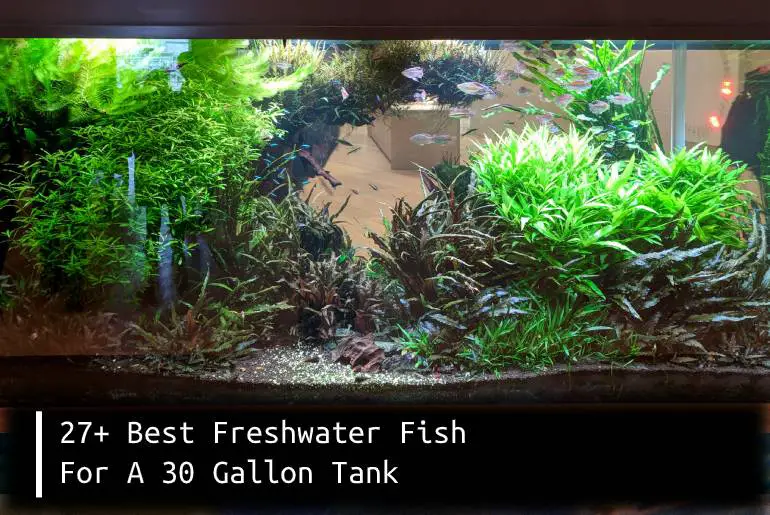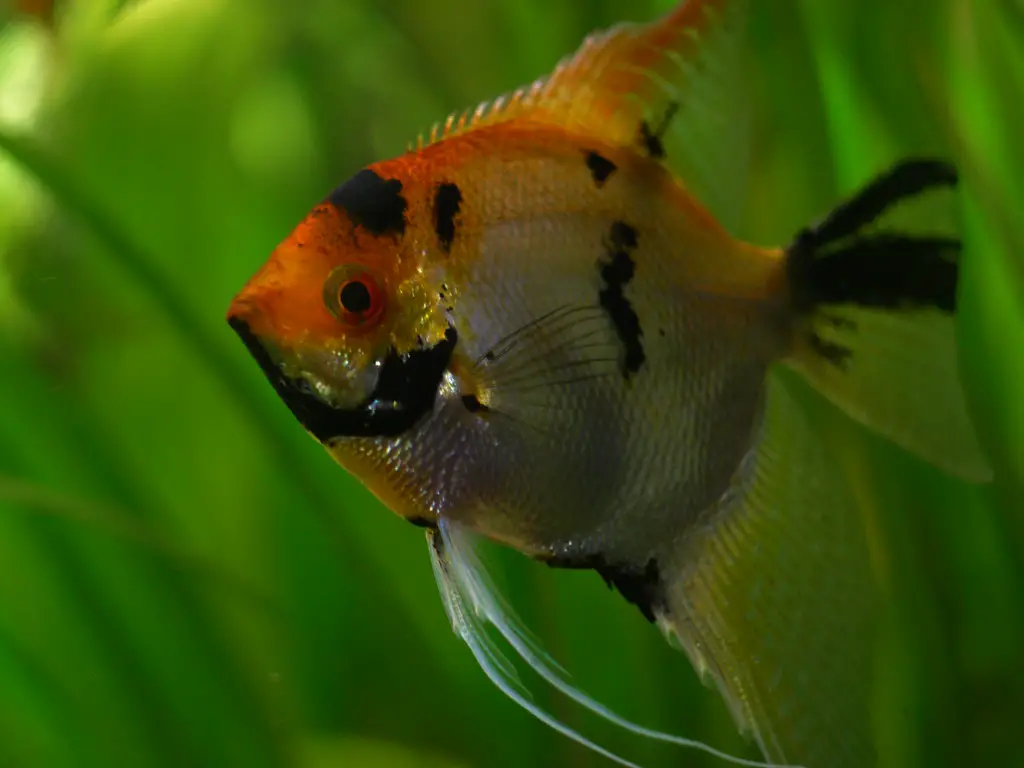Fishkeeping has become a very popular hobby these days. Basically, as fish are easy to keep and comes in varieties, the number of fish-keeping enthusiasts is increasing day by day. One of the perks of fish is that almost everyone can get a variety of freshwater fish for their home. Especially, if you have a medium-sized tank like 30 gallons, you can easily set it up with different kinds of fish. But what are the best freshwater fish for a 30-gallon tank?
A 30-gallon tank can hold varieties of freshwater fish, it can be Guppies, Mollies, Dwarf Gouramis, Tetras, Cichlids, Bettas, Khuli Loach, and Angelfish. In addition to this, you can even keep other types of fish in a 30-gallon tank like Rainbowfish, Goldfish, Rasboras, Catfishes, and Scarlet badis.
Off course! The list of freshwater fish best for your 30-gallon tank doesn’t end here and goes on in on. However, today I will explicitly talk about 30 of them. I hope this article will make it easier for you to choose what’s best for you.
What Should You Know About 30 Gallon Freshwater Fish Tank?
I know I have said to you earlier that fish are easy to care for, and I am not at all wrong. Fish indeed is the easiest pet you can have at home. But, having said that, it doesn’t been you can be careless. There are certain things you should know beforehand.
A 30-Gallon Tank Is Alternative To A Large Aquarium For Freshwater Fish
I won’t say that 30 gallons is a huge size, I have seen fish growing in even bigger tanks. But, a 30-gallon tank is good enough for you to have different kinds of freshwater fish, and even some saltwater ones too.
A 30-gallon tank can is similar to a large aquarium, just that the former is for freshwater fish and the latter is for saltwater ones. You can keep varieties of plants and fish in it.
How Many Freshwater Fish Can You Keep In A 30-Gallon Tank?
Most aquarists usually follow the one-inch of fish per gallon rule. This means that for a 30-gallon tank, you can keep up to 30 inches of fish. But, this is not an accurate way to determine how many fish your tank can support. You need to consider different factors like the size, nature, and temperament of your fish when stocking a 30-gallon tank.
If you have small fish, then you can keep more than 12 of them. But, if you have medium or large-sized fish, then it is better to keep only six to eight fish. When stocking a 30-gallon tank, it is important to choose the right mix of fish. You need to consider the compatibility of your fish and their care requirements too. It is also important to have a good balance of male and female fish.
What Are The Best Plants For A 30-Gallon Tank?
A 30-gallon tank is a big enough tank that can hold a good number of fish. Not only can these, but the tank of this size also has a wide range of plant life that can live in it. Here are some of the best plants for a 30-gallon tank:
- Anubias
- African Water Fern
- Java Fern
- Water Wisteria
- Dwarf Aquarium Lily
- Amazon Sword
- Cryptocoryne Beckettii
You can pick any plant from this list and be sure that it will do well in your 30-gallon tank. However, do remember that the number of plants also plays a role in the health of your fish. So, it’s better to not overstock your tank with plants.
Do you have a 30-gallon fish tank? What plants do you have in it?
What Are The Problems With Keeping A 30-Gallon Tank?
When you decide to keep a tank, you need to bear in mind that it comes with some responsibilities. If you fail to take care of your tank, you will face some problems.
One main problem related to a 30-gallon tank is, that it is quite difficult to find the right fish for this tank. Moreover, the fish in this tank is more susceptible to illness and even die.
In addition to this, some beginners assume a 30-gallon tank to be a very big tank. Thus, they will stock the tank with too many fish which will lead to aggression and stress. Similarly, with more fish, the problem of more waste production and a foul-smelling tank might also develop.
These are only a few of the major problems. You certainly will face a lot more issues over time and will also learn to deal with them eventually.
What Type Of Fish Is Best For Your 30 Gallon Tank?
Certainly, it is not necessary that the fish that does well in my tank fits yours too even though the tank size is the same. There are various other factors that influence the fish that does well in a tank. And these factors are:
- the water condition
- size and type of fish you keep
- the temperament of the fish
- humidity and temperature of your place
- the type of substrate you have
After this, it’s time you need to know about all the best options you have. So, here is an account of all the best freshwater fish that you can have in a 30-gallon tank.
Best Freshwater Fish For A 30 Gallon Tank
When you have a wide range of options to choose from, it becomes difficult to pick out the best from them. Moreover, each fish behaves differently in different environments. So, a fish that is best for the same volume a tank in your place might do just fine in your friend’s tank.
Therefore, when it comes to deciding the best fish for a 30-gallon tank, you need to choose very wisely. Here are some best freshwater fish options for a 30 Gallon Tank. Go through all of them and decide the one you want.
Congo Tetras (Phenacogrammus interruptus)
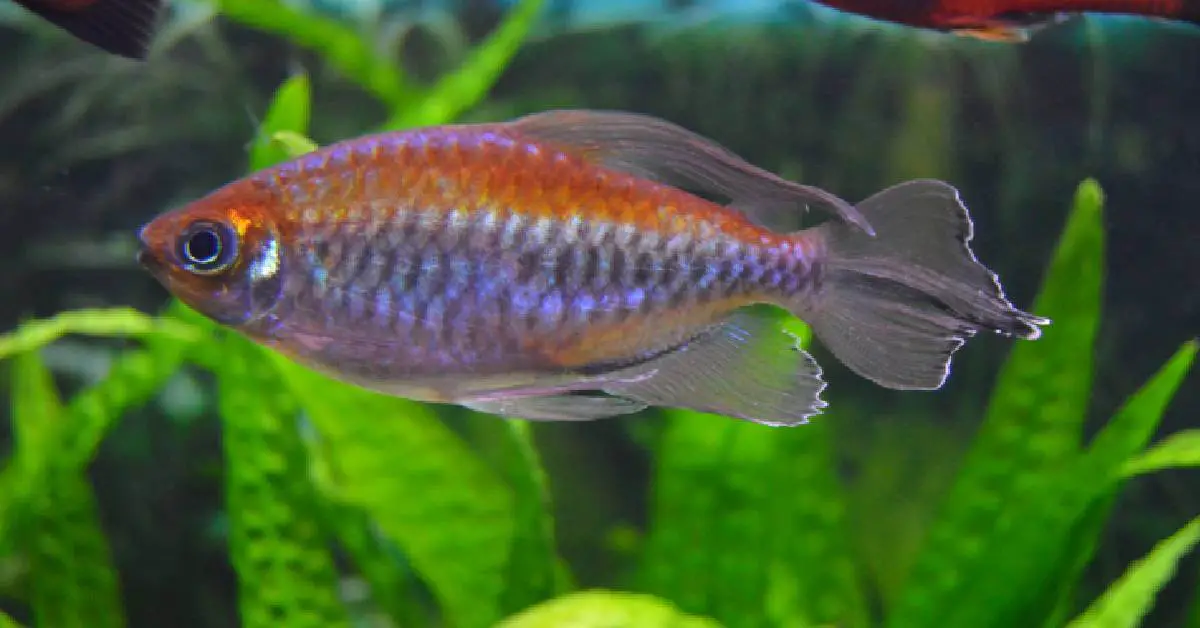
The Congo Tetra is a freshwater fish that originates from the upper Congo River Basin in Africa. They are a relatively small fish, only growing to about 3 inches in length. Congo Tetras are very peaceful and make an excellent addition to any community tank. They prefer warmer water (72°F to 82°F) with a neutral pH (6.0 to 7.5) and moderate hardness (3 to 18 dGH).
Usually, they will do best in an aquarium that is at least 30 gallons in size. When kept in a smaller tank, Congo Tetras are more susceptible to stress-related problems such as disease and aggression.
Therefore, it is important to provide them with plenty of space to swim and hide. Overall, Congo Tetras are hardy fish that make a great choice for beginners. With proper care, they can live for 3 to 5 years in the home aquarium.
Red Shoulder Dwarf Cichlid (Apistogramma macmasteri)
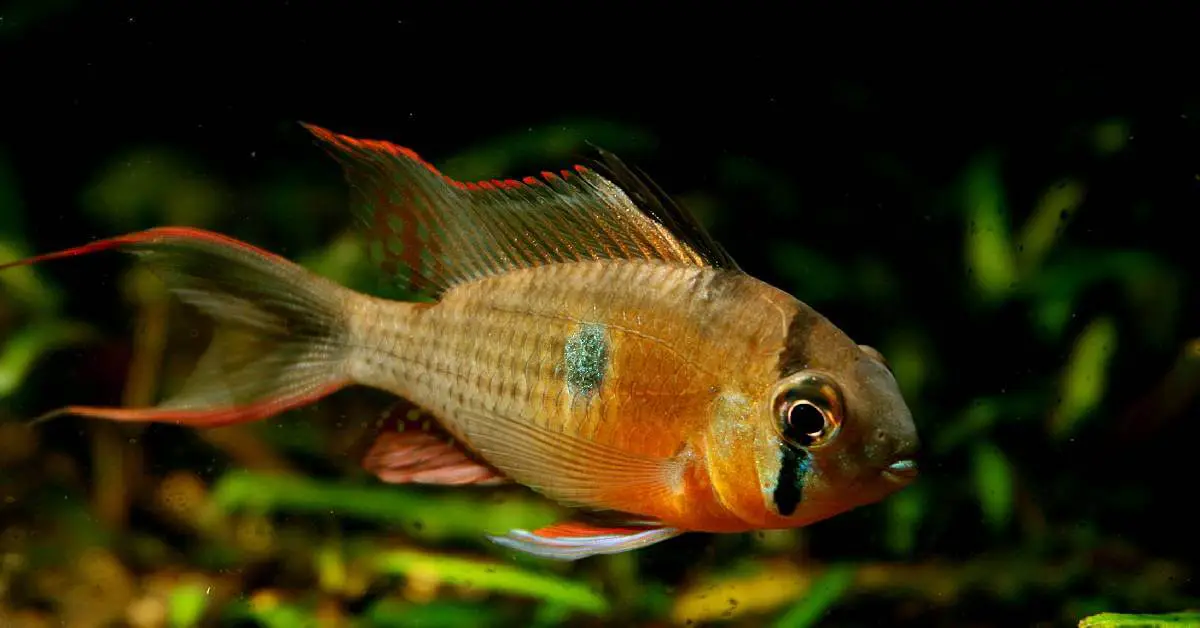
Red Shoulder Dwarf Cichlids are beautiful freshwater fish that originates from South America. They are very small, only reaching about 3 inches in length when fully grown.
Red Shoulder Dwarf cichlids prefer warm water (72° – 86° F) with a neutral pH (6.0-7.0), and they need a tank of at least 15 gallons in order to thrive. These fish are very active and need plenty of space to swim, so a smaller tank is not ideal.
When choosing tank mates for Red Shoulder Dwarf cichlids, it is important to select species that have similar size and water requirements. These fish can be aggressive towards each other, so it is best to keep them in pairs or groups of 4-6 individuals.
Red Shoulder Dwarf cichlids are relatively easy to care for, but they are sensitive to changes in water parameters. It is important to test the water regularly and do weekly water changes to maintain a healthy environment for these fish.
Pearl Gourami (Trichopodus leerii)
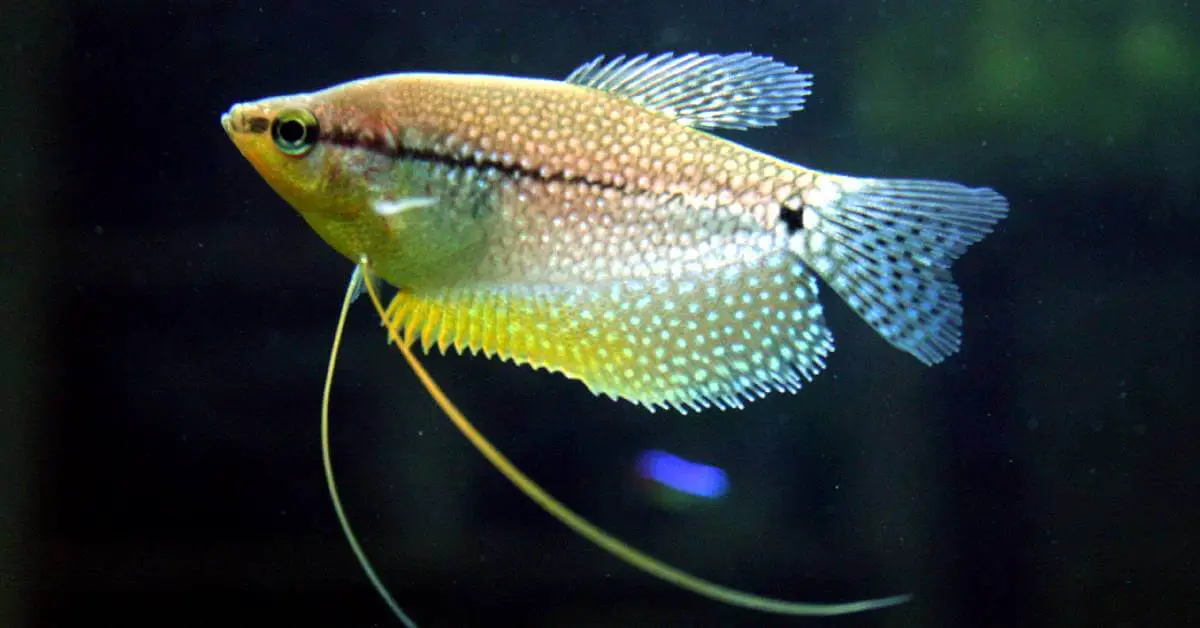
The Pearl Gourami is a freshwater fish that originates from Southeast Asia (Thailand, Malaysia, and the islands of Borneo and Sumatra). It is a member of the Osphronemidae family, which also includes the popular Betta fish. Pearl Gouramis are relatively small fish, and they can reach a maximum of four to five inches.
Pearl Gouramis typically inhabit slow-moving rivers and streams with plenty of vegetation. When it comes to keeping them in a home aquarium, a 30-gallon tank is usually sufficient. In terms of water parameters, they prefer neutral to slightly acidic water (5.5 to 7.5) with a temperature range of 72-82 degrees Fahrenheit.
However, it’s important to keep in mind that Pearl Gouramis are social creatures, and they should be kept in groups of at least four fish. If they are kept in too small of a tank, or if they don’t have enough company, they can become stressed and develop related problems such as fin biting.
Jewel Cichlid (Hemichromis bimaculatus)
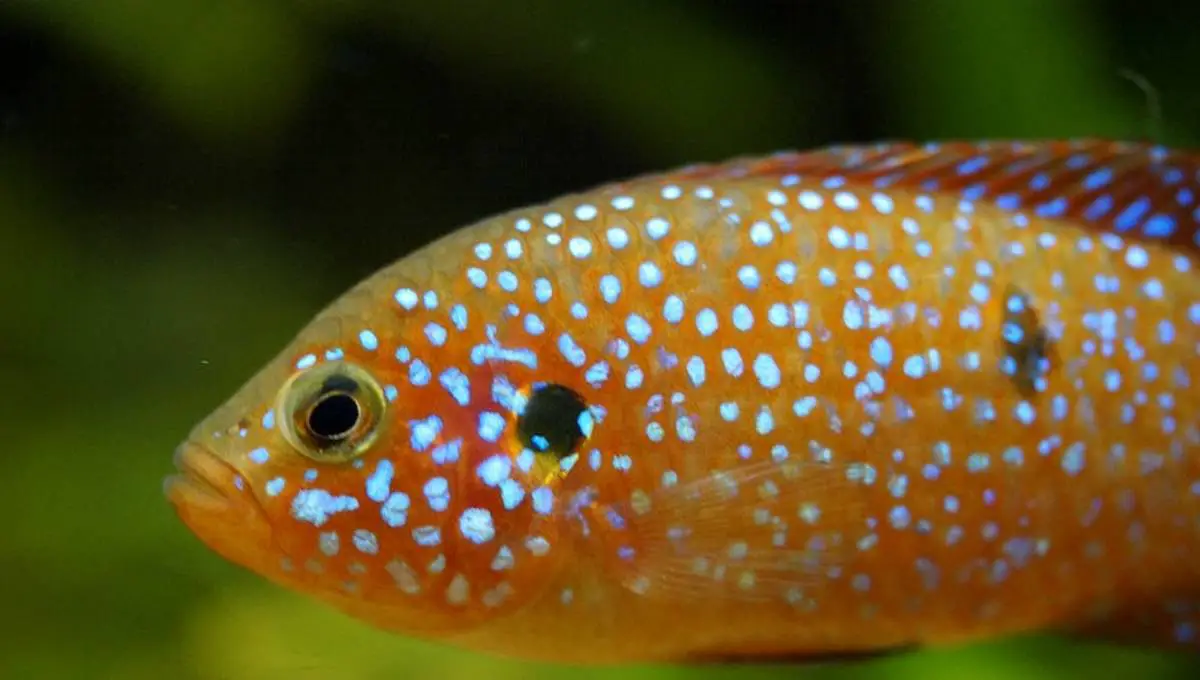
Jewel cichlids are a species of freshwater fish that originates from the rivers and lakes of West Africa. These fish are relatively small, only growing to be about 4 inches in length.
However, they are very aggressive and can be territorial towards both their own species as well as other tank mates. As a result, it is important to provide them with plenty of hiding places and to choose tankmates carefully. Some of the fish that go well with Jewel Cichlids are Rainbowfish, Electric Blue Acaras, Redtail Shark, Clown Loaches, Plecos, and Giant Dianos.
Usually, jewel cichlids prefer water that is on the alkaline side with a pH level of 6.5 to 7.5. They also prefer water that is warm, with a temperature range of 75°F and 80°F. In terms of environment, jewel cichlids prefer a tank that is heavily planted and has lots of hiding places.
A 30-gallon tank is the minimum size you should use for these fish, and even then, you should only keep one or two fish in the tank. If you keep more than that, you run the risk of aggression and health-related problems.
Rainbow Kribensis (Pelvicachromis pulcher)

The Rainbow Kribensis, also known as the Purple Krib or Red-eyed Krib. This beautiful fish originates from the African waters of southern Nigeria and the coastal areas of Cameroon and typically grows to be about four inches long. These fish are relatively easy to care for, but there are a few things to keep in mind when adding them to your tank.
Rainbow Kribensis prefer water that is on the acidic side with a pH of 5.6 and 7.0 and a temperature of 75-80 degrees Fahrenheit. They also prefer tanks that are at least 30 gallons in size, as this provides them with enough space to swim and explore. In terms of tank mates,
Rainbow Kribensis can be kept with other peaceful fish that have similar water parameters. It’s important to note that these fish may become aggressive during the spawning season, so be sure to provide them with plenty of hiding places. All in all, the Rainbow Kribensis is a great addition to any 30-gallon tank and is sure to add some color and personality to your aquarium.
Florida Flag Fish (Jordenella floridae)
The Florida Flag Fish is a native of the southeastern United States (Florida Peninsula south of the drainage basins of the St. Johns River and Ochlockonee River). It’s a small fish, only reaching about two inches in size. The Florida Flag Fish does best in tanks that are at least 30 gallons in size. This fish is relatively easy to care for, but there are a few things to keep in mind.
First, the Florida Flag Fish prefers warm water, so the tank should be kept between 75 and 82 degrees Fahrenheit. Second, the Florida Flag Fish is a peaceful species, so it’s best to avoid putting it in a tank with aggressive fish. Finally, the Florida Flag Fish is known to eat live plants, so it’s best to stick with artificial plants.
When kept in the proper environment, the Florida Flag Fish makes an excellent addition to any tank. Just be sure to give it plenty of space to swim!
Fancy Guppy (Poecilia reticulata)
The Fancy Guppy, also known as the Millionfish and Rainbow Bamboo Shrimp, is a small freshwater shrimp that originates from Southeast Asia. They are a popular aquarium fish due to their vibrant colors and relatively low maintenance requirements.
Fancy Guppies can reach up to 2.5 centimeters in length and should be kept in an aquarium that is at least 30 gallons in size. They prefer water that is neutral to slightly acidic with a temperature range of 72-82 degrees Fahrenheit. In terms of diet, Fancy Guppies are omnivores and will eat a variety of pellets, flakes, and live foods.
When it comes to tank mates, it is best to avoid aggressive fish, as Fancy Guppies are peaceful by nature. All in all, the Fancy Guppy makes an excellent addition to any 30-gallon tank.
Celestial Pearl Danio (Danio margaritatus)
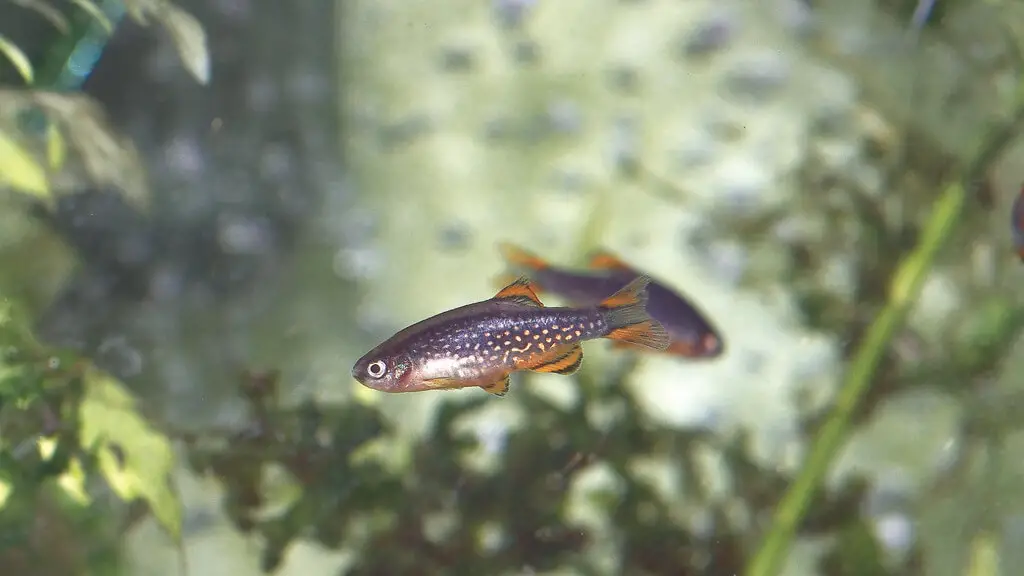
Celestial Pearl Danio, or Galaxy Rasbora, is a beautiful freshwater fish that originates from Myanmar. It’s one of the smallest members of the Cyprinid family and can grow to be about an inch long. The fish is silver with black spots and has an iridescent sheen.
They are schooling fish, so it’s best to keep them in groups of 5 or more. They are peaceful fish and can do well with other peaceful species. The Galaxy Rasbora prefers clean water with neutral pH and moderate hardness. The tank size should be at least 30 gallons, but the bigger, the better since they are active swimmers.
Since they come from slow-moving streams, make sure there is plenty of vegetation and hiding places in the tank. Driftwood is also a good addition. Galaxy Rasboras are sensitive to changes in water parameters and sudden changes in temperature, so it’s important to acclimate them slowly to new environments. With proper care, these beautiful fish can thrive in a home aquarium.
Harlequin Rasboras (Trigonostogma hetermorpha)
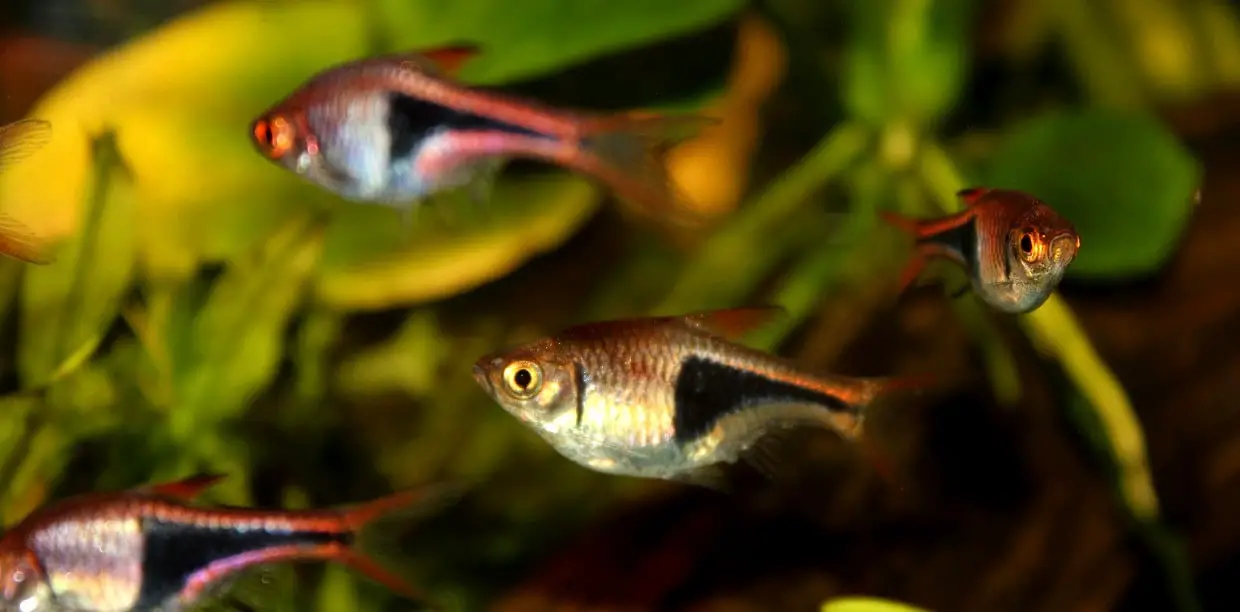
The Harlequin Rasbora originates from Southeast Asia, where it can be found in slow-moving rivers and streams. It’s a relatively small fish, growing to a maximum length of 2.5 inches. When it comes to water parameters, the Harlequin Rasbora prefers slightly acidic water with a pH of 6.0-7.5. It also does best in a tank with soft water.
In terms of environment, the Harlequin Rasbora is a peaceful fish that does well in groups. A 30-gallon tank is a minimum size you should consider for this fish, as they need plenty of space to swim and school. That said, if you plan on keeping a group of Harlequin Rasboras, you’ll need an even larger tank.
One potential issue to be aware of with this fish is that it’s susceptible to velvet disease, ich, and other parasites. To help prevent these problems, make sure you keep your tank clean and maintain good water quality.
Overall, the Harlequin Rasbora is a great choice for beginner aquarists or anyone looking for a peaceful community fish. Thanks to its small size and low maintenance requirements, it’s also an excellent option for a 30-gallon tank.
Cherry Barbs (Puntis Titteya)

Cherry barbs (Puntius titteya) are small, peaceful fish that originates from Sri Lanka. They grow to be about 2 inches long and prefer water that is on the alkaline side with a pH of 7.0-8.0. They also prefer water that is well-oxygenated and has a moderate flow.
In the wild, they can be found in slow-moving rivers and streams with densely planted areas. Cherry barbs are schooling fish, so they should be kept in groups of 6 or more. A 30-gallon tank is the minimum recommended size for a group of cherry barbs, but a larger tank is always better.
As with all fish, cherry barbs produce waste that can contribute to ammonia levels in the tank. Therefore, it’s important to have good filtration and to do regular water changes. Cherry barbs are relatively easy to care for and make an excellent addition to any peaceful community tank.
Bluefin Notho (Nothobranchius rachovii)

The Bluefin Notho is a freshwater fish that originates from Southeast Asia. It’s a relatively small fish, only reaching about 4 inches in length when fully grown. Bluefin Nothos are peaceful fish that do well in community tanks. They prefer water with neutral pH and moderate hardness levels.
In the wild, Bluefin Nothos are found in slow-moving rivers and streams with plenty of vegetation. When choosing a tank for your Bluefin Notho, it’s important to provide plenty of places for them to hide and swim. A 30-gallon tank is a good size for this fish, but you may need a larger tank if you plan on keeping more than one.
The biggest downside to keeping a Bluefin Notho is their vulnerability to diseases like white spots and ich. However, as long as you keep their tank clean and maintain good water quality, they should be healthy fish.
All in all, the Bluefin Notho is a great choice for beginner aquarium enthusiasts. They’re relatively easy to care for and make a beautiful addition to any community tank.
Endlers (Poecilia wingei)
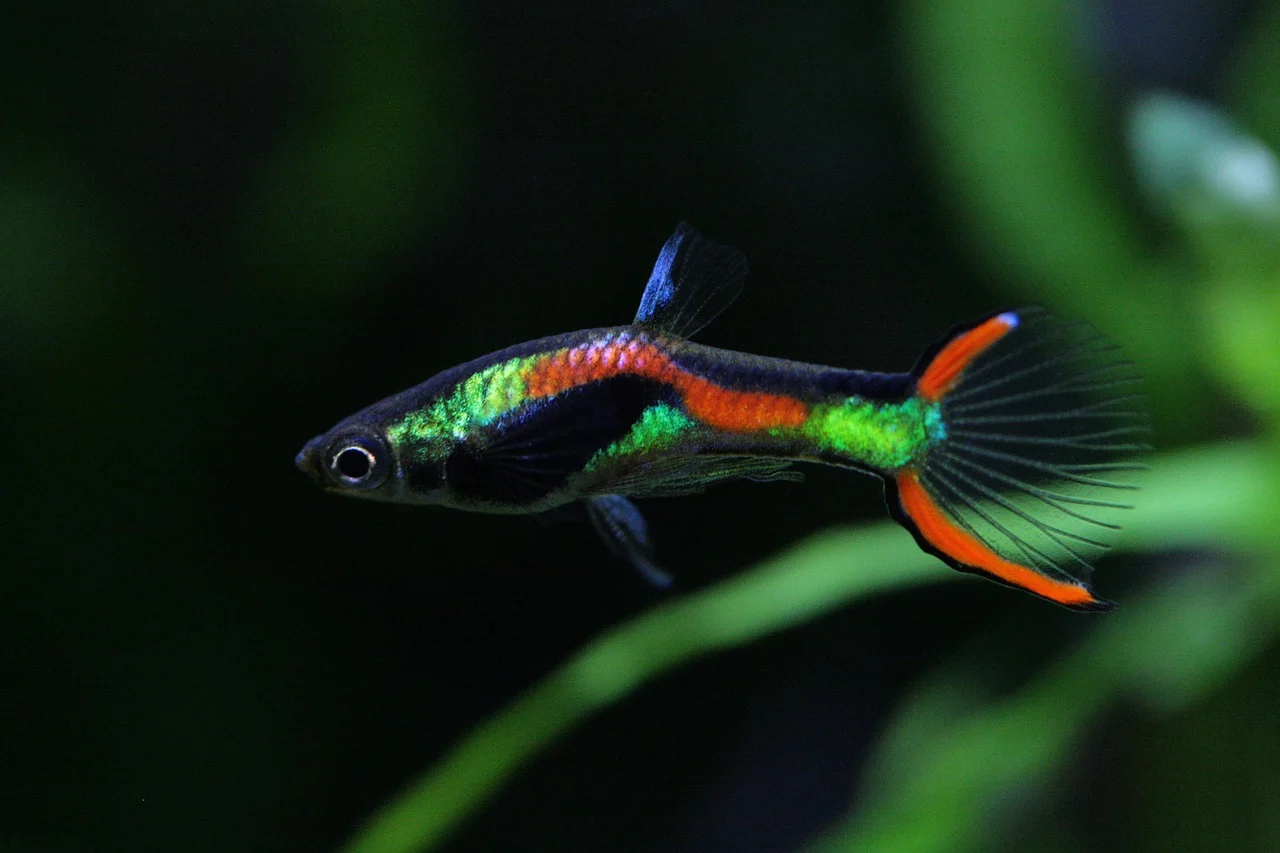
Endler’s livebearers are small freshwater fish that originates from the rainforests of South America. They are a popular choice for aquariums because of their small size (only reaching about 1.5 inches in length) and their bright colors. They are also relatively easy to care for, as long as their tank is the correct size.
While Endler’s can technically be kept in a 30-gallon tank, it is not recommended. A 30-gallon tank is simply too small to provide the necessary environment for these fish to thrive. Endlers are active swimmers and need a lot of space to move around. They also prefer slightly brackish water, so a 30-gallon tank would not be able to replicate their natural habitat.
In addition, keeping Endlers in a small tank increases the risk of related problems, such as poor water quality and aggression among fish. For these reasons, it is best to keep Endlers in a tank that is at least 55 gallons. While this may seem like a lot of work, it will ultimately create a better environment for your fish – and result in fewer problems down the road.
Paradise Fish (Macropodus opercularis)
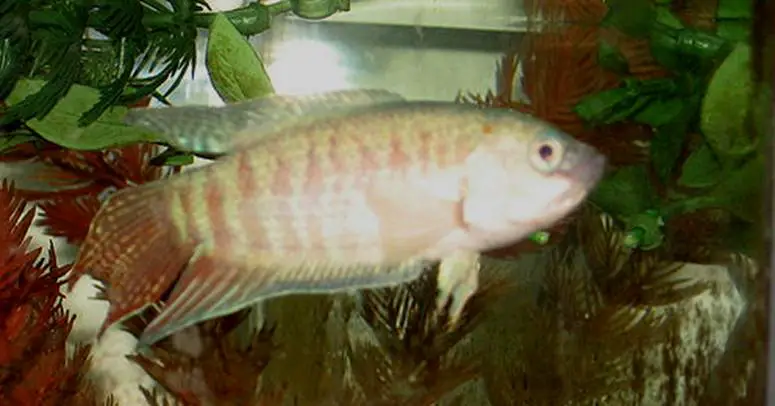
The Paradise fish originates from Southeast Asia and is a member of the gourami family. It is a beautiful fish with bright colors, and it is a perfect addition to any aquarium. The paradise fish can reach a length of six inches, making it one of the larger members of the gourami family.
However, it is still a relatively small fish and can be kept in a 30-gallon tank. Although the paradise fish is a beautiful and popular fish, it can be aggressive towards other tank mates. It is best to keep only one paradise fish per tank. If you are interested in keeping more than one fish, you should consider a larger tank size.
The paradise fish requires warm water temperatures and does not do well in cold water. It is important to maintain stable water parameters in your aquarium to ensure the health of your fish. Keeping the paradise fish in an aquarium with proper care will result in a happy and healthy fish that can live for many years.
Dwarf Gourami (Trichogaster lalius)

The Dwarf Gourami is a freshwater fish that originates from South Asia. It is a popular choice for aquariums because of its vibrant coloration and relatively small size.
Dwarf Gouramis typically grow to be about two inches in length, making them a good option for smaller tanks. They also prefer warm water with a neutral pH level, which can be easily achieved in a well-maintained aquarium.
However, it is important to provide plenty of hiding places for Dwarf Gouramis, as they can be easily stressed by bright lighting and active tank mates. In general, a 30-gallon tank is a minimum size recommended for keeping Dwarf Gouramis, but a larger tank will provide more space for them to swim and explore.
Ultimately, the decision of whether or not to keep a Dwarf Gourami in a 30-gallon tank depends on the individual fish and the other inhabitants of the tank. With careful planning and consideration, it is possible to maintain a happy and healthy aquarium that meets the needs of all its residents.
Neon Tetra (Paracheirodon innesi)

Neon Tetras are freshwater fish that originates from the Amazon River Basin in South America. They are small fish, only growing to be about 1-2 inches long. Neon Tetras are also very delicate fish, and they need to be kept in an aquarium with very specific water parameters. The water needs to be soft and acidic, with a temperature range of 70-80 degrees Fahrenheit.
Neon Tetras also need to be kept in groups of at least 6 fish. They are very social creatures and will become stressed if they do not have other Neon Tetras to interact with. When kept in a properly maintained aquarium, Neon Tetras are relatively easy to care for and make great beginner fish.
However, because of their delicate nature, they are not the best fish for a 30-gallon tank. A 30-gallon tank is simply too small to provide the proper environment for Neon Tetras. There are much better fish for a 30-gallon tank, such as Guppies or Platies.
Cardinal Tetra (Paracheirodon axelrodi)
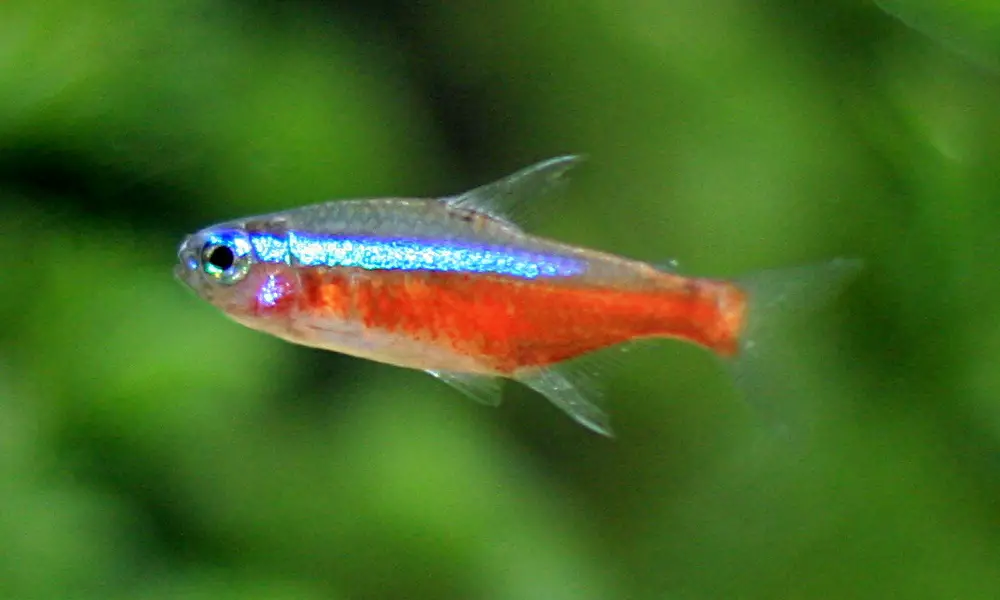
The Cardinal Tetra is a small freshwater fish that originates in the streams and rivers of South America. They are popular among aquarium enthusiasts due to their bright colors and peaceful nature.
Cardinal Tetras grow to be about 2.5 inches long and can live for 5-10 years with proper care. They prefer waters with a neutral pH and moderate hardness and should be kept in a tank that is at least 30 gallons. However, it is important to note that Cardinal Tetras are sensitive to changes in their environment, and even small fluctuations can cause stress or illness.
As a result, it is best to avoid keeping them in tanks that are less than 30 gallons. In addition, Cardinal Tetras are social creatures and should be kept in groups of at least 5-6 fish. Otherwise, they may become stressed or aggressive.
All in all, the Cardinal Tetra is a beautiful and low-maintenance fish that makes an ideal addition to any community tank. However, potential owners should be aware of the special care requirements that come with keeping this delicate species.
Betta (Betta splendens)

Bettas, also known as Siamese fighting fish, are a popular choice for beginner fish keepers. Originally from Southeast Asia, they are available in a wide range of colors and patterns. While they are often kept in small bowls or tanks, Bettas can actually grow quite large, reaching up to three inches in length.
Water parameters Bettas prefers warm water with a pH level between 6.5 and 7.5. They are also a labyrinth fish, meaning that they have a unique organ that allows them to breathe surface air. As a result, they do not require an air pump or filter in their tank.
However, they do produce a fair amount of waste, so regular water changes are essential. Tank size The minimum recommended tank size for a Betta is two gallons. Nevertheless, a larger tank is always better, as it provides the fish with more room to swim and reduces the risk of water quality problems.
Disease-related problems Bettas are susceptible to several diseases, including Tail Rot and Fin Rot. These diseases are often caused by poor water quality, so maintaining a clean tank is essential. In addition, Bettas can be territorial and aggressive towards other fish, so it is important to choose tank mates carefully.
German Blue Ram (Mikrogeophagus ramirezi)

The German Blue Ram (Mikrogeophagus ramirezi) is a small, freshwater fish that originates from the Orinoco River Basin in South America. German Blue Rams typically grow to be about 2-3 inches in length, and they are very peaceful fish. They are also very easy to care for, as long as their water parameters are kept in check.
German Blue Rams prefer a slightly acidic environment with a pH of 6.0-7.0, and they like water temperatures of 76-82 degrees Fahrenheit. They can live in both community tanks and single-species tanks, but they should not be kept with any fish that are much larger than them. A 30-gallon tank is a perfect size for a German Blue Ram, and these fish are relatively low-maintenance compared to other aquarium fish.
The only downside to keeping a German Blue Ram is that they are susceptible to diseases such as Ich and velvet, so it is important to keep a close eye on their health. All in all, the German Blue Ram is an ideal fish for beginners who are looking for a low-maintenance pet.
Discus (Symphysodon sp.)
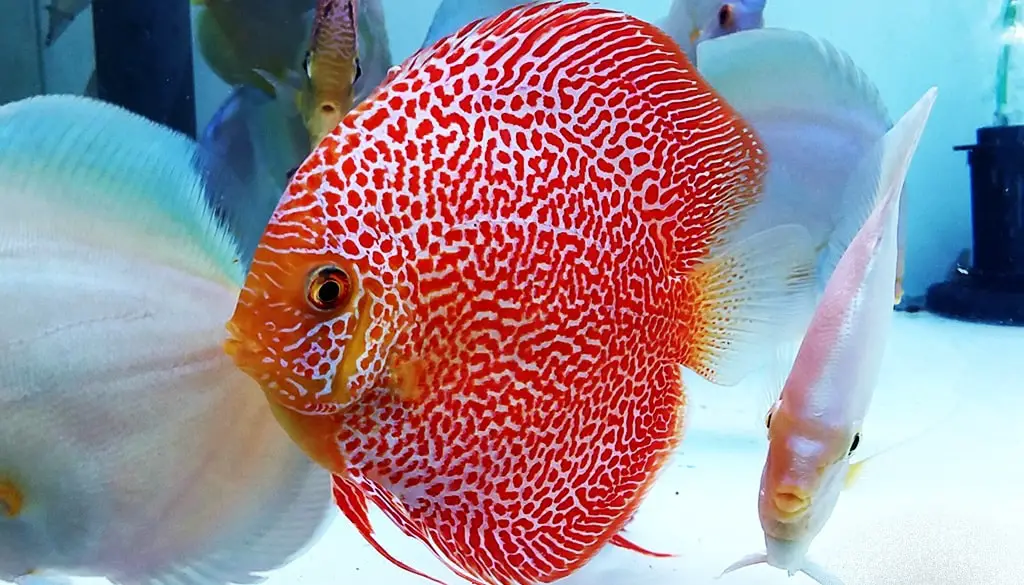
Discus originates from Southeast Asia and can be found in various freshwater habitats such as ponds, rivers, and lakes. It is a relatively small fish, only growing to be about 4 inches long. When it comes to water parameters, Discus prefers neutral to slightly acidic water with a temperature range of 72-78 degrees Fahrenheit.
It also does best in an environment that has plenty of hiding places, such as plants and rocks. As for tank size, a 30-gallon tank is a minimum size that should be considered for keeping Discus. Anything smaller than that, and you may start to run into problems related to water quality and stress levels.
Although Discus is a relatively easy fish to care for, there are still a few things to keep in mind. For example, they are not the best community fish because they can be quite aggressive towards smaller or weaker fish. They are also known to eat plants, so if you plan on keeping live plants in your tank, you may want to consider another fish species.
All things considered, Discus is a great choice for freshwater beginners who are looking for a hardy and low-maintenance fish.
Angelfish (Pterophyllum scalare)
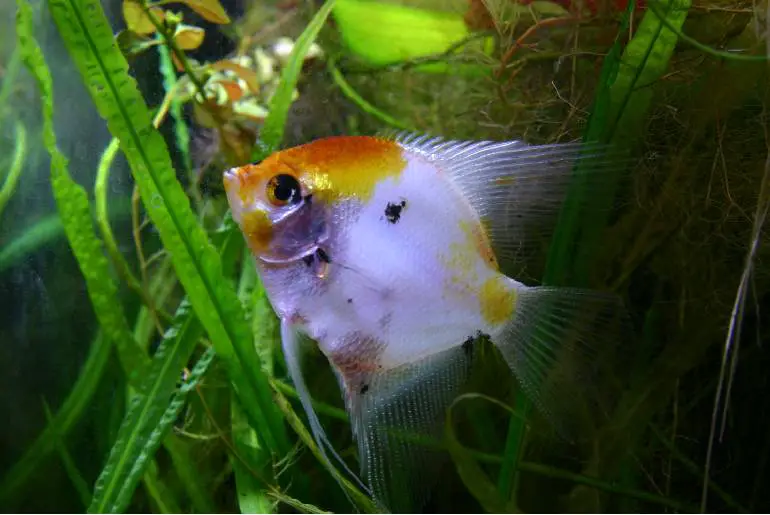
The origin of the angelfish is South America, more particularly in the Amazon Basin. Their size reaches up to 6 inches (15 cm) long. As for the water parameters, they need warm water, with a temperature ranging from 75 to 86 degrees Fahrenheit (24 – 30 degrees Celsius), a pH level of 6.0 – 8.0, and a hardness of 5 – 15 dGH. They prefer a heavily planted tank with hiding places, but their fins are vulnerable to nipping fish, so they choose tank mates carefully.
The recommended tank size for keeping angelfish is at least 30 gallons (114 L). However, bigger is better. Unfortunately, one of the cons of keeping these fish is that they are known jumpers, so make sure your aquarium is covered. They can also be prone to several related problems such as swim bladder disease, ich infections, and fin rot.
Although they might be a little high-maintenance, once you set up a proper environment, they are relatively easy to take care of and definitely worth it! They are truly beautiful fish that will add some flair to your home aquarium.
Platies (Xiphophorus maculatus)
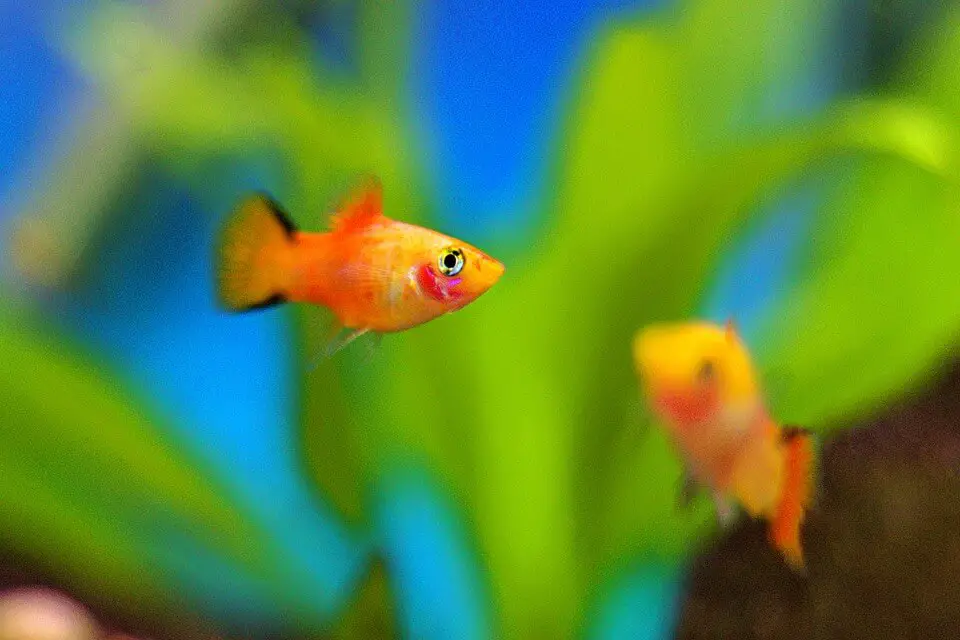
Platies are small, hardy freshwater fish that originates from Central America. They are livebearers, meaning they give birth to live young instead of laying eggs. Platies are a popular choice for beginner aquarium keepers because they are easy to care for and relatively tolerant of poor water conditions.
However, they do best in an aquarium that is at least 30 gallons in size. This allows them enough space to swim and also provides some room for plants and other tank mates. While platies can tolerate a wide range of water parameters, they prefer water that is on the softer side with a neutral pH.
In terms of tank mates, platies do best with other peaceful, small fish. Larger fish may view them as food, and aggressive fish may bully them. Overall, platies are good beginner fish for a 30-gallon tank. They are relatively easy to care for and can tolerate a wide range of water conditions.
Rainbow Fish (Marosatherina ladigesi)
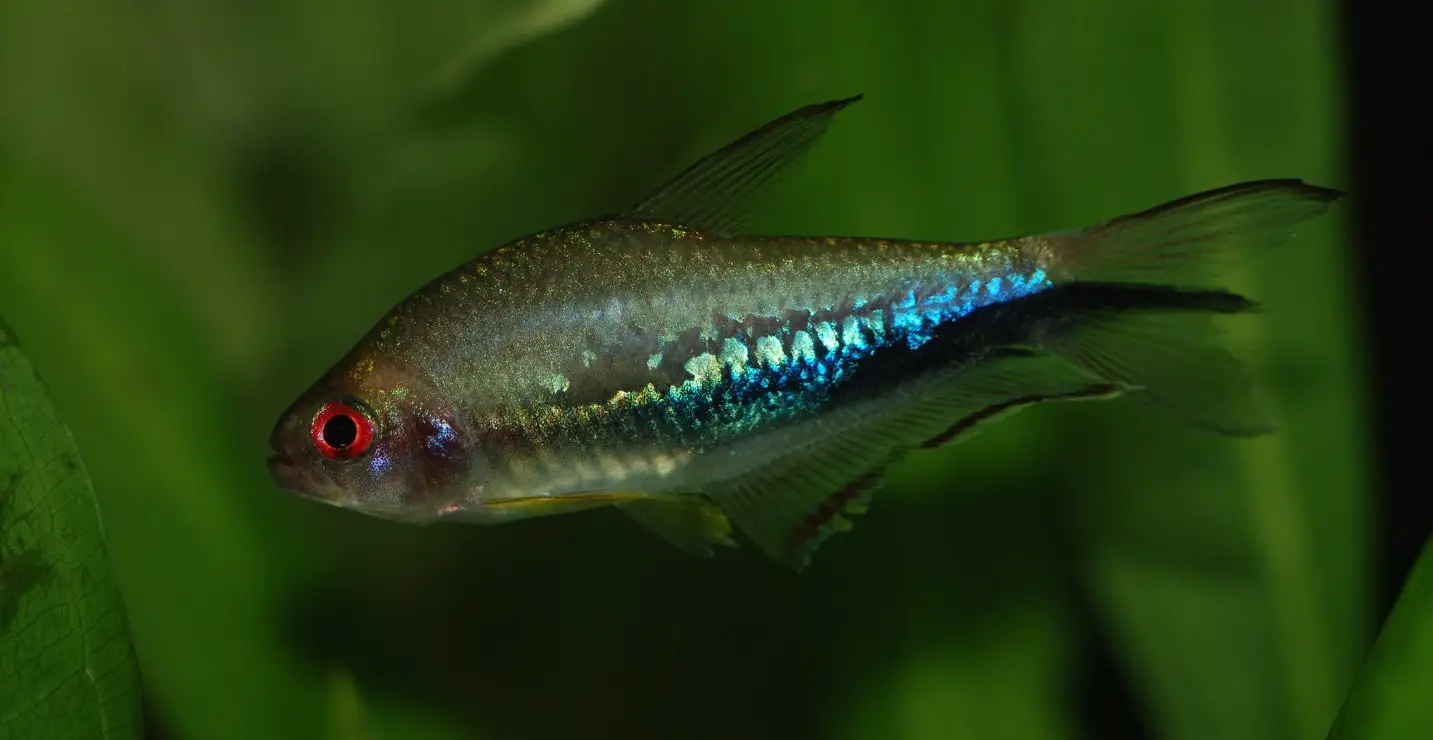
The Rainbow Fish is a species of freshwater fish that originates from the rivers and streams of New Guinea. They are one of the most popular aquarium fish due to their brightly colored scales, which can range in hue from golden yellow to deep blue.
Rainbows grow to an average size of six inches, making them a good choice for smaller tanks. However, they are also very active swimmers and require a tank that is at least 30 gallons in size.
When it comes to water parameters, Rainbows prefer water that is neutral to slightly acidic with a moderate level of hardness. They also prefer an environment that is well-oxygenated and has plenty of hiding places. Although they are not typically aggressive, they can be territorial towards other fish with similar color patterns.
As a result, it is best to keep only one Rainbow per tank unless the tank is large enough to accommodate a small group.
Cory Catfish (Corydoras paleatus)
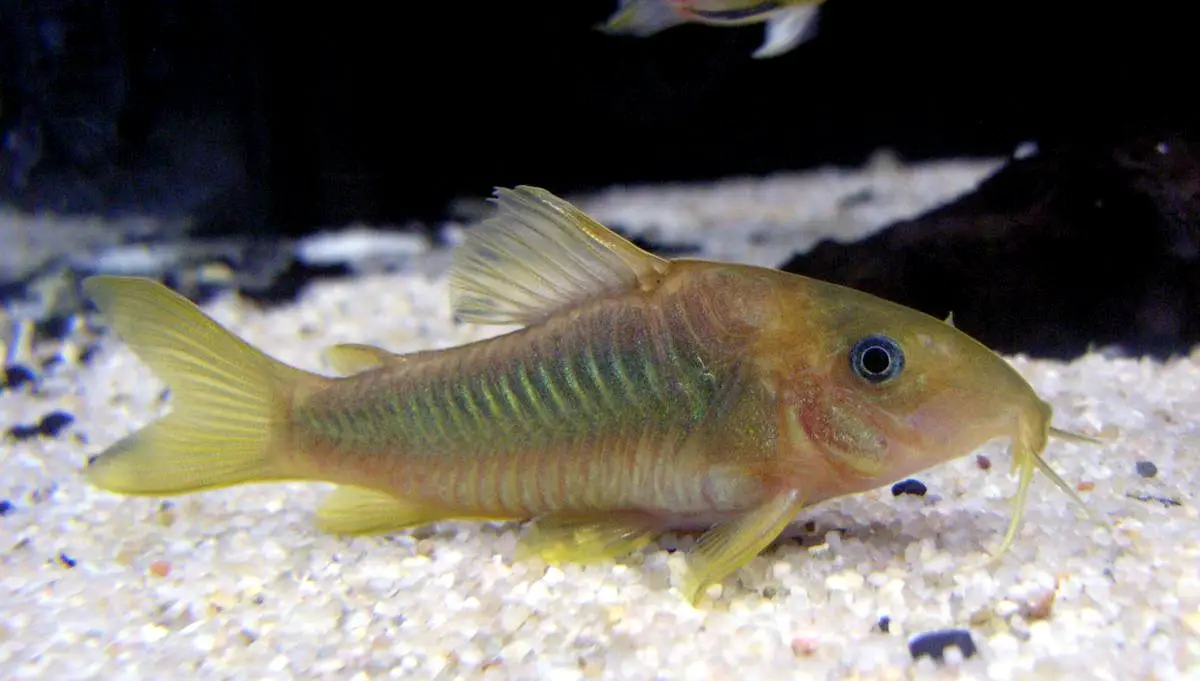
Cory Catfish are a popular choice for freshwater aquariums. They originate from South America and can grow up to 4 inches in length. Cory Catfish prefer water with a neutral pH and moderate hardness, making them well-suited for a wide range of environments.
Perhaps the most appealing aspect of Cory Catfish is their relatively small size; a 30-gallon tank is more than sufficient to house a small school of these fish. In addition, Cory Catfish are peaceful and can be kept with a wide variety of other fish species.
However, there are a few potential drawbacks to keeping Cory Catfish. Because they spend much of their time near the bottom of the tank, they can be sensitive to poor water quality. In addition, Cory Catfish are social creatures and should be kept in groups of at least 3-5 fish.
Bristlenose Plecos (Ancistrus cirrhosus)

Bristlenose plecos are a type of armored catfish that originates from the rivers of South America. They are small fish, only growing to be about 4-6 inches in length. Bristlenose plecos are peaceful fish that do well in tanks with other peaceful fish. They prefer tank sizes of at least 30 gallons and do best in tanks with plenty of hiding places and lots of live plants.
Bristlenose plecos are relatively easy to care for, as long as their water parameters are kept within a certain range. They are sensitive to changes in pH and water temperature, so it is important to monitor these carefully. One of the few cons of keeping bristlenose plecos is that they can sometimes overeat and cause problems with water quality.
However, as long as they are kept in a suitable environment and their tank size is appropriate, they make excellent additions to most freshwater aquariums.
Killifish (Fundulus heteroclitus)
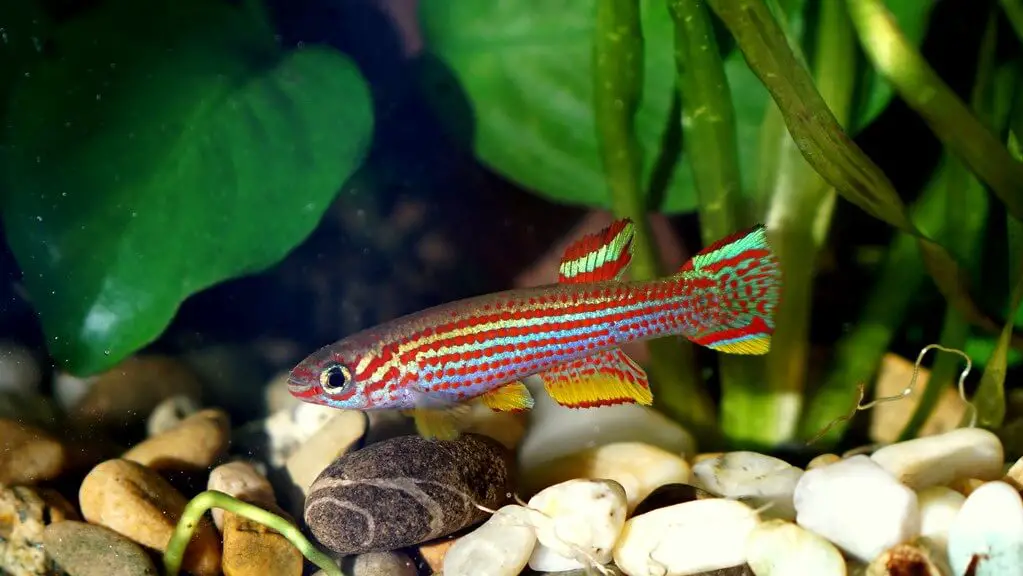
Killifish are a freshwater fish that originates from Africa. They are small fish, only growing to be about 2 inches in length. When it comes to water parameters, they prefer water that is neutral to slightly alkaline with a temperature range of 72-82 degrees Fahrenheit. In their natural environment, they are found in ponds and marshes with dense vegetation.
When it comes to tank size, a 30-gallon tank is a minimum size you can keep them in. However, it is best to keep them in a larger tank if possible, as they are very active swimmers. They also like to have a lot of hiding places, so be sure to include plenty of plants and other decorations in their tank.
One downside of keeping killifish is that they are not very tolerant of other fish and can be aggressive towards them. Therefore, it is best to keep them alone or with other killifish.
Kuhli Loaches (Pangio kuhlii)

Kuhli loaches originate from Southeast Asia, and they are usually between 2.5 to 4 inches long. These fish prefer slightly acidic water with a temperature range of 68 to 86 degrees Fahrenheit, although they can survive in a wide range of water parameters. They prefer a sandy substrate with plenty of hiding places such as driftwood and live plants.
A 30-gallon tank is a minimum size recommended for keeping kuhli loaches, and a group of at least 5 should be kept together. Kuhli loaches are peaceful fish that get along well with other tank mates of similar size. They are nocturnal feeders and will often hide during the day.
If you are thinking of keeping kuhli loaches, it is important to be aware that they are escape artists and can wriggle through tiny gaps, so make sure your tank is well-sealed. Overall, kuhli loaches make great additions to any aquarium and are relatively easy to care for as long as their basic needs are met.
Molly Fish (Poecilia sphenops)
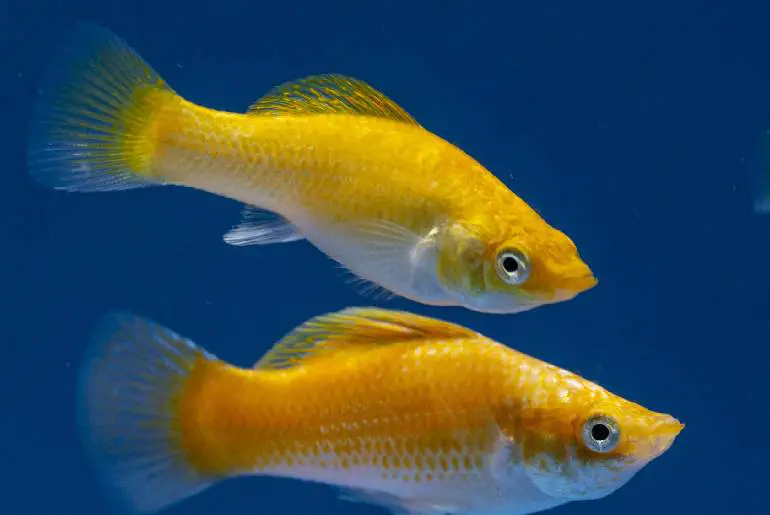
Molly Fish is a popular freshwater fish that originates from Central America. They are known for their peaceful nature and can be a great addition to any community tank. Molly Fish come in a variety of colors and patterns, and they typically grow to be about 4 inches in length.
When it comes to keeping Molly Fish in a 30-gallon tank, there are both pros and cons to consider. On the plus side, Molly Fish are relatively easy to care for and can tolerate a wide range of water parameters. They also prefer to live in a densely-planted tank, which can help to reduce stress levels and provide plenty of hiding places.
However, there are a few potential downsides to keeping Molly Fish in a small tank. First, they are very active swimmers and may quickly outgrow a 30-gallon tank. Second, because they are such social creatures, they may become stressed if they don’t have enough space to move around.
For these reasons, it’s important to do your research before deciding whether or not Molly Fish is the right fish for your 30-gallon tank.
Goldfish (Carassius auratus)
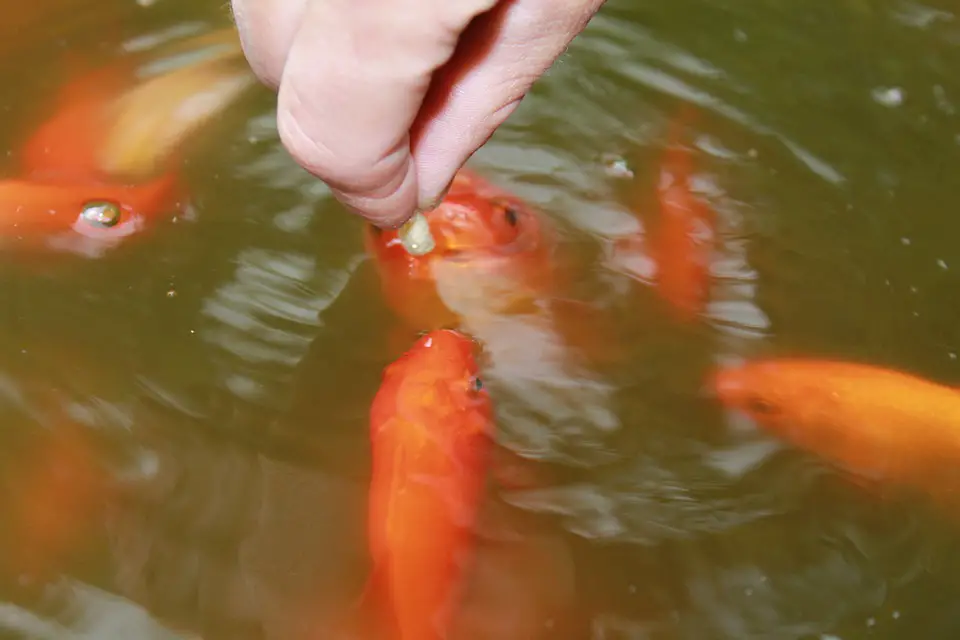
Though they are commonly thought of as beginner’s fish, goldfish are actually quite delicate creatures that require a great deal of care and attention. Goldfish originate from China, where they were first bred for color mutations. Today, there are many different varieties of goldfish available, but they all share a few common traits.
Goldfish are typically small fish with a maximum size of around 18 inches. They are also coldwater fish, meaning that they cannot tolerate water temperatures above 75 degrees Fahrenheit.
In the wild, goldfish live in ponds and rivers with plenty of vegetation. As a result, they do best in aquariums or tanks that are at least 30 gallons in size and have plenty of live plants. Goldfish also produce a great deal of waste, so it is important to maintain clean water parameters and perform regular water changes.
Otos (Otocinclus vittatus)
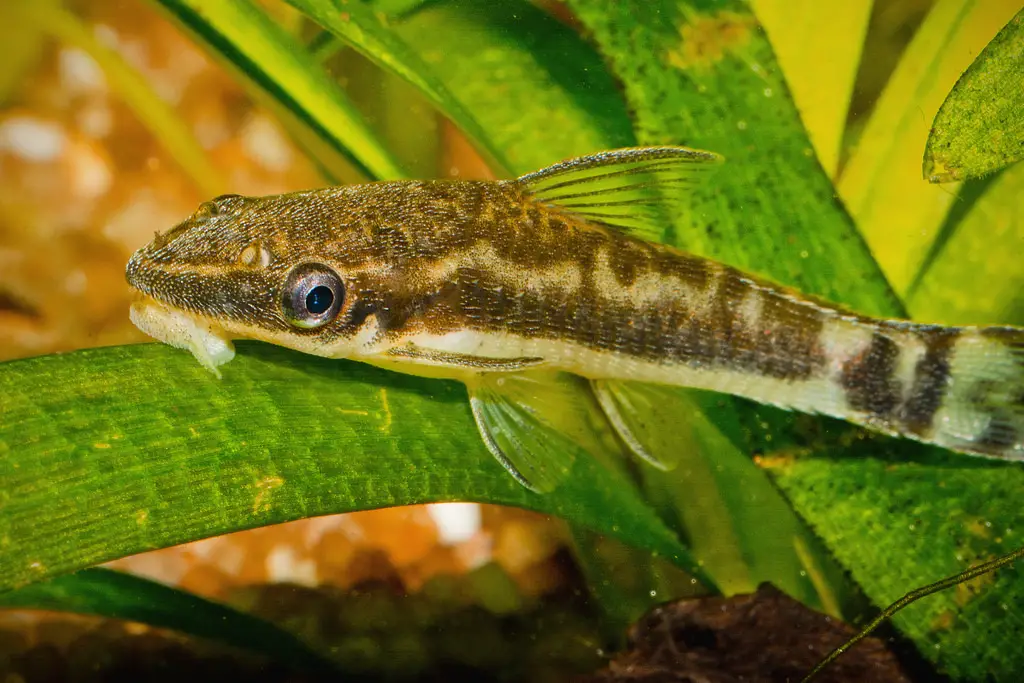
Otos are a type of freshwater fish that originates from South America. They are small in size (1 to 2 inches), and they prefer to live in tanks with soft water. The ideal water parameters for keeping Otos are a pH of 6.5-7.5, a temperature of 72-86 degrees Fahrenheit, and a hardness of 2-12 dGH.
Otos are best for tanks that are at least 30 gallons in size. This tank gives them enough room to swim and explore their environment. You can comfortably keep around 3 Otos in a 30-gallon tank.
One of the main benefits of keeping Otos is that they help to keep algae growth under control. They will also consume any leftover food that sinks to the bottom of the tank, which helps to keep the tank clean.
However, one potential downside of keeping Otos is that they are sensitive to changes in water quality and parameters. As a result, it is important to regularly test the water in their tank and make any necessary adjustments.
Scarlet Badis (Dario dario)
![Scarlet badis [Dario Dario]](https://fishkeepingguide.net/wp-content/uploads/2020/04/Dario_DarioScarlet_badis.webp)
The Scarlet Badis is a freshwater fish that originates from South and Southeast Asia. It’s a relatively small fish, only reaching about 2 inches in length when fully grown. The Scarlet Badis prefers water with a neutral pH and moderate hardness levels, and it does best in an aquarium that has plenty of hiding places.
A 30-gallon tank is a minimum size for keeping these fish, as they need plenty of space to swim around and explore. Some of the pros include their peaceful nature (they generally get along well with other fish), their beautiful coloration, and the fact that they are not too demanding in terms of water parameters.
Some of the cons include their small size (which can make them easy prey to larger fish). In addition to this, they are slow growers (so it might take a while for them to reach their full size). All in all, the Scarlet Badis is a great option for those looking for a beautiful and low-maintenance addition to their aquarium.
So, what fish have you decided to keep? Are you thinking of keeping different fish in combination? However, whatever is your choice, setting up a tank is a crucial step in fishkeeping.
How To Set Up A 30-Gallon Tank For Your Freshwater Fish?
Beginners think that setting up a tank is a very daunting task. Especially, if your tank is as big as 30 gallons, you need to put quite some work and effort into setting up the tank. However, I do have a few tips and steps that will make it easier for you. If you follow them, I bet you will not even realize how fast it is done.
First, you need to clean the tank. For that, you can use warm water and a sponge. Make sure to remove all the dirt and algae as well as the substrates and decoration.
Then, you need to add some plants and decorations. This is completely up to you and your fish. Some fish like hiding spots, while others like open spaces.
After that, you need to fill the tank with water. You can use a hose or a bucket for that. I would recommend using a conditioner to make sure the water is safe for your fish.
Once you fill a quarter of the tank, you then need to add your fish. I would recommend adding one fish at a time and giving them a few days to adjust to their new environment.
Lastly, do not forget to insert an appropriate filter, heater, and lighting system into your tank. These are very important for the health of your fish.
Now you have a beautiful and healthy 30-gallon tank ready for your freshwater fish!
What Are The Necessary Equipment For A 30 Gallon Freshwater Fish Tank?
It isn’t quite possible to maintain a healthy and thriving freshwater fish tank without the proper equipment. This is especially true for those who are new to owning a fish tank. If you’re planning to set up a 30-gallon freshwater fish tank, you’ll need more than just the basics.
So, here is a list of necessary equipment for a 30-gallon freshwater fish tank.
Filter
The most important part of freshwater fish tank equipment is the filter. A good quality filter will help to keep your water clean and clear. Moreover, the filter also provides a place for beneficial bacteria to grow. These bacteria are responsible for breaking down waste products in the water.
I would recommend you buy a filter with a calculated water flow of 150 gallons per hour for your 30-gallon freshwater fish tank. However, you can get a lot of options in the market (Hang on back filters, internal power filters, external canister filters, under gravel, etc.). You can choose any filter as per your budget and fish tank size.
Filters:
Heater
Another necessary tool for a 30-gallon freshwater fish tank is a heater. A lot of tropical fish species require a water temperature of 78 degrees Fahrenheit. So, you will need to purchase a heater that can maintain the water temperature in your fish tank.
Usually, it is best to buy a 100 to 150-watt heater for a 30-gallon freshwater fish tank. The best options for a 30-gallon fish tank are the submersible aquarium heater, Cobalt Aquatics Neo-Therm, Eheim Jager Aquarium Heater, Aqueon Pro Heaters, and many more.
HEATERS:
- HITOP PTC Adjustable Aquarium Heater, Sturdy Fish Tank Heater with Protective Cover, 100W/200W/300W/400W Heater for Fresh/Saltwater Fish/Turtle Tank up to 120 Gallon
- hygger Variable Frequency Aquarium Heater, 500W Quartz Fish Tank Heater with LED Digital Display Thermostat Controller for 50-100 Gallon Freshwater Saltwater Tank
- Eheim 3619090 Jager Aquarium Thermostat Heater 300W, Black
- Fluval E200 Advanced Electronic Heater, 100-Watt Heater for Aquariums up to 65 Gal., A773
Thermometer
A thermometer is also necessary equipment for a freshwater fish tank. It will help you to keep track of the water temperature in your fish tank. There are different types of thermometers available in the market (analog, digital, stick-on, etc.). You can choose any thermometer as per your budget and fish tank size.
I would recommend you buy a digital aquarium thermometer because it is easy to use and accurate. Some of the best options for a 30-gallon freshwater fish tank are the HDE LCD Digital Aquarium Thermometer, Marina Floating Thermometer, JW Pet Company Aquarium Thermometer, and Zacro LCD Digital Aquarium Thermometer.
Substrate
The substrate is the material that you put at the bottom of your fish tank. It can be anything from gravel to sand to rocks. The substrate also plays an important role in the freshwater fish tank. It provides a place for beneficial bacteria to grow, helps to keep the water clean, and provides a natural look to your fish tank.
For a 30-gallon freshwater fish tank, I would recommend you use a mix of gravel and sand as the substrate. Some of the best options are Carib Sea Eco-Complete Planted Black Aquarium Substrate, Fluval Plant and Shrimp Substrate, SeaChem Aquarium Substrate, Activ-Flora Floracor for Aquarium, etc.
- Carib Sea ACS05820 Super Natural Moonlight Sand for Aquarium, 5-Pound
- Carib Sea ACS05840 Super Naturals Crystal River Sand for Aquarium, 5-Pound
- SACKORANGE 2 LB Aquarium Gravel River Rock – Natural Polished Decorative Gravel, Small Decorative Pebbles, Mixed Color Stones,for Aquariums, Landscaping, Vase Fillers (32-Oz)
Plants
Plants are also a necessary part of a freshwater fish tank. They help to keep the water quality high and provide a place for fish to hide. There are many different types of plants that can be used in a freshwater fish tank. Some of the best plants for a 30-gallon tank include Java Fern, Anubias, and Hornwort.
Lighting
Proper lighting is also necessary for a freshwater fish tank. It not only provides a natural look to your fish tank but also helps the plants to grow. The type of lighting you need for your fish tank depends on the type of plants you have in your aquarium.
If you have live plants in your 30-gallon freshwater fish tank, then you will need to purchase a full-spectrum LED light, like AI Prime 16 HD Reef Aquarium LED, Current USA Orbit Marine LED Aquarium Light, VIPARSPECTRA Marine LED light, etc.
However, if you don’t have live plants in your fish tank, then you can use any type of lighting (incandescent, fluorescent, or LED).
Other Equipment
There are some other necessary equipments that you will need for your 30-gallon freshwater fish tank, like:
- Water pump: A water pump is necessary to circulate the water in your fish tank. It also helps to keep the water clean and oxygenated.
- Aquarium stand: An aquarium stand is necessary to support your fish tank.
- Gravel vacuum gravel: A vacuum is necessary to clean the substrate in your fish tank
- Fishnet: A fishnet is necessary to catch and move the fish in your fish tank.
- Aquarium test kit: An aquarium test kit is necessary to test the water quality in your fish tank.
You can get all of these from your local pet store.
Benefits Of A 30 Gallon Freshwater Fish Tank
Now that you are familiar with all the necessary information about a 30-gallon tank. You might find it easier to pinpoint why you should choose this tank. However, if you still have some confusion about the advantages of a 30-gallon tank. I have shortlisted all of them below:
- A 30-gallon tank is a perfect size for beginner fish keepers. It is not too big or small and can house a good number of fish.
- This freshwater tank can accommodate a wide variety of different fish species. Thus, it the perfect option for those looking to set up a community tank.
- You can easily manage a tank of this size, and it will not take up too much space in your home.
- A 30-gallon tank is also a cost-effective option for those on a budget.
- This tank does not need highly specialized equipment and can be set up with a basic fish tank kit.
Now that you know the benefits of a 30-gallon freshwater fish tank. You can make an informed decision on whether this is the right size tank for your needs or not! If you want a smaller one, you can easily get a 5, 10, or 10-gallon tank. Similarly, for a bigger tank, you have 40, 50, and 55-gallon options. It’s all up to you.
Where Can You Buy A 30 Gallon Freshwater Fish Tank?
Are you looking to buy a beautiful buddy for your aquarium? You might be finding it difficult to decide where to buy the fish. Definitely, choosing your fish from the right place is very important if you want a healthier fish. So, here are few options where you can buy a 30-gallon freshwater fish and tank.
Online Stores
Petsmart and Petco are the most common places people buy their fish. They both offer a wide variety of freshwater fish. However, they can be a little more expensive than other options.
Retailers
Another option is online retailers, such as Amazon or Chewy. They usually have a wider selection of fish and tanks than physical stores. Plus, you can often find good deals on fish and tanks on these websites.
Local Fish Stores
Finally, you could always go to your local fish store. This is a great option if you want to talk to someone in person about what kind of fish would be best for your tank. Plus, they usually have a good selection of freshwater fish.
How Much Does A 30 Gallon Freshwater Tank Cost?
The cost of a 30-gallon freshwater fish tank can vary depending on where you buy it and what kind of fish you put in it. Generally, you can expect to spend around $100 on a basic 30-gallon freshwater fish tank. However, if you want a more elaborate setup with different kinds of fish, you could end up spending closer to $500.
No matter how much you spend on your fish tank, it’s important to remember that the most important thing is providing a safe and healthy environment for your fish.
FAQs
What Is The Dimension Of A 30 Gallon Freshwater Fish Tank?
The dimensions of a 30-gallon freshwater fish tank are 30 inches long, 12 inches wide, and 18 inches tall.
What Is The Best Filter For A 30 Gallon Freshwater Fish Tank?
One of the best filters for a 30-gallon freshwater fish tank is the AquaClear Power Filter. It is an all-in-one filter that includes a pump, media, and spray bar. It is also easy to install and provides good filtration for your fish tank.
What Is The Best Single Fish For A 30 Gallon Tank?
Some of the best single fish for a 30-gallon tank include bettas, goldfish, and guppies. These fish are all relatively easy to care for and don’t need a lot of space to swim.
What Are The Best Plants For A 30 Gallon Freshwater Tank?
Some of the best plants for a 30-gallon freshwater tank include Sword plants, Java Ferns, and Anubias. These plants are all low-maintenance and can help to create a beautiful underwater landscape for your fish.
What Are The Best Bottom Feeders For a 30 Gallon Tank?
Some of the best bottom feeders for a 30-gallon tank include plecos, corydoras, and loaches. These fish are all great at helping to keep your tank clean and can add some interesting variety to your aquarium.
Summary
Now that you know everything about a 30-gallon fish tank, it’s time to get one for yourself! These tanks are perfect for beginner fish keepers and can accommodate a wide variety of different fish species. So what are you waiting for? Get a 30 gallon freshwater fish tank today!
If you have any questions or comments, please feel free to leave them below. I would love to hear from you! Until next time, happy fish keeping!

